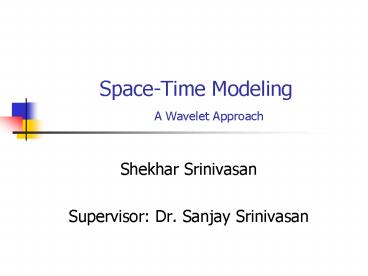SpaceTime Modeling A Wavelet Approach PowerPoint PPT Presentation
1 / 25
Title: SpaceTime Modeling A Wavelet Approach
1
Space-Time Modeling A Wavelet Approach
- Shekhar Srinivasan
- Supervisor Dr. Sanjay Srinivasan
2
Objective
- Dynamic variables Pressure signals, flow
response - Spatially variable attributes
- Prediction of value at any given spatial location
and time instant - Modeling spatiotemporal behavior of dynamic
variables
3
Objective
- Pressure P f(u,t)
- Expressing the trend as linear combination
- Correlate the parameters in space
- Develop parameter set at unsampled locations
using stochastic simulation - Regenerate pressure or flow response at that
location
4
Highlights
- Principles of Fourier Transforms
- Drawbacks
- Concept of Wavelets and Wavelet Transforms
- Multi-resolution Analysis
- Application to Space-Time modeling
- Results
- Conclusions
5
Principles of Fourier Transforms
- Decomposition of a signal into a sine wave of
different frequencies - Frequency- vibration about a mean
- Ideal for periodic signals
- Periodic signals-Fast Fourier Transforms
- Aperiodic signals- Discrete Time Fourier
Transforms
6
Fourier transform Concept
Frequency domain
f(t)
Time
7
Drawbacks
- Cannot operate simultaneously in both domains
- Need to define a single transform for dual
representation of the energy density of a signal - Cannot capture discontinuities in the transient
signal effectively - Need large number of coefficients
- Tedious exercise to carry out kriging for large
number of coefficients
8
Wavelets Objectives
- Capture coarse and fine details of a transient
signal - Expressing any signal as a linear combination of
well defined functions - Scaling translation parameters
9
Wavelets Concept
- Discretization
- Box function b(x) 0,1
- b(2kx-n)
- k scaling parameter
- n translation parameter
- Weighting step functions (Haar Wavelet)
- Summing up the weighted functions
10
Wavelets Concept
- Coarser Averaging
- Finer Differencing
- Why ?
- Lifting Scheme of wavelets
11
Wavelets Binary tree
- Coarse signal at level n
- Coarse at n-1
- Fine at level n-1
- Retain detail
- Split coarse part of signal
Sn
Sn-1
Dn-1
Dn-2
Sn-2
Sn-3
Dn-3
12
Geostatistical Nomenclature
- Random variables
- Uncertainty characterized by random function
Cumulative distribution - Univariate, Bivariate, Multivariate distributions
- Spatial correlation Variogram
- Techniques - Kriging, Simulation
13
Kriging- A Brief Overview
- Generic form of linear regression
- Express estimate as linear combination of data
- Minimize variance subject to constraints
- Matrix of equations containing covariance
- Covariance Inferred from variogram
- Estimate Mean value
- Revisit Discrete Time Fourier transform
14
Stochastic Simulation
- Kriging maps are smooth- dampen variability
- Add residual variability to kriged map
- Simulated maps actual variability
- Sequential Simulation
- Define random path to visit all nodes in a
reservoir - Univariate Bivariate Multivariate
15
Testing on Synfields
- Four well model 1 injector, 3 producers
- Anisotropic permeability field
- Permeability barriers
- Analyze correlation of the wavelet parameters
- Get an idea of hetrogeneity
16
Case 1
P2
I1
P3
P1
- P1 I1 oriented perpendicular to anisotropy
- P2 P3 oriented parallel to anisotropy
17
Case 2
- P1 I1 oriented perpendicular to anisotropy
- P2 P3 oriented parallel to anisotropy
P1
P3
P2
I1
I1 P2 oriented parellel to anisotropy, no
barrier P1 P3 equidistant from I1, barrier
18
Algorithm
- Define a reservoir model
- Develop wavelet coefficients for available wells
- Develop variogram from the permeability field
- Use the same variogram model to generate all
coefficients using kriging or SGSIM - Use the generated coefficients to generate
pressure profile - Verify by simulating pressure profile at a given
location
19
Ensuring consistency with geology
20
Reservoir model
- Producer
- Injector
Simulated node
21
Results
SGSIM
Wavelet parameter map
- Permeability field
22
Comparison
23
Conclusions
- Correlation coefficient depends on the direction
of orientation - Depends on the distance between injector and
producer - Pressure response is directly correlated to the
permeability field - Single variogram model suffices to generate the
wavelet parameters at unknown locations - Variogram model can be determined from
permeability field
24
Suggested work
- Extend the exercise to 3D modeling
- Test the exercise on a real model
- Carry out the exercise using other robust wavelet
schemes like Lifting Scheme
25
Acknowledgements
- Dr. John Gilbert
- Dept. of Mathematics
- University of Texas Austin

